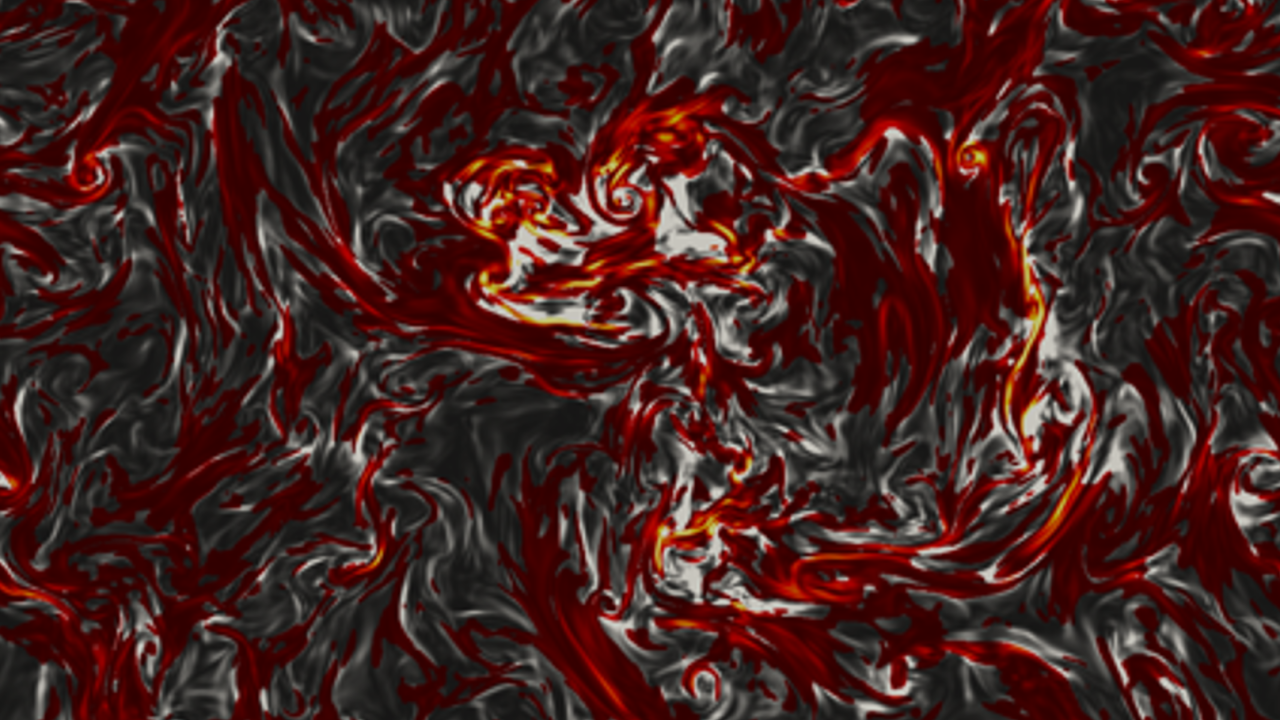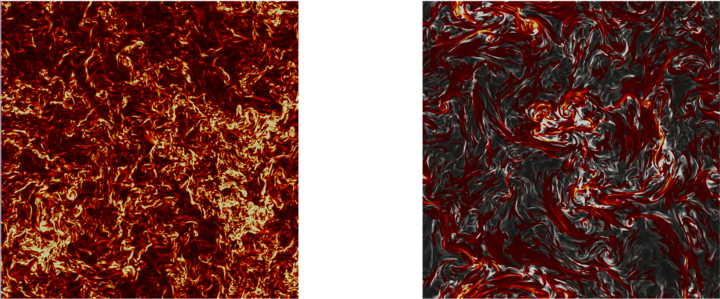Towards a Deeper Understanding of Turbulence in Elastoviscoplastic Fluids

Three-dimensional simulations shed light on how energy dissipates within non-Newtonian fluids (fluids in which viscosity depend on the shear rate.) The result is valuable in the context of disaster forecast and management or industrial production.
Elastoviscoplastic (EVP) fluids like mud, concrete, and lava are a type of non-Newtonian fluid that exhibit both solid and fluid-like behavior depending on the forces they are subjected to (i.e., applied stress). Their flow behavior is more complex than that of Newtonian fluids, such as water and air, which have a constant viscosity. In a recent study, researchers performed simulations of turbulent EVP fluids, revealing novel insights on the energy transfer mechanism across different scales.
Water, air, oil, and alcohol are well-known examples of fluids. However, they only constitute a particular subset of the possible types of fluids, namely the subset of Newtonian fluids. As the name suggests, Newtonian fluids are those that obey Newton’s law of viscosity, characterized by a linear relation between the shear stress and the shear rate. Another way to put it is that the viscosity of Newtonian fluids is independent of the shear rate.
In contrast, non-Newtonian fluids do not follow this classical definition, meaning their viscosity changes depending on the forces they are subjected to. For example, elastoviscoplastic (EVP) fluids are a type of non-Newtonian fluid that behave either like a solid or fluid depending on the applied stress. At low stress, they tend to preserve their shape and resist deformation. In contrast, at high stress, they flow like liquids. While EVP fluids are less common than Newtonian fluids in our daily lives, some familiar examples include mud, concrete, and toothpaste.
It turns out that understanding how EVP fluids behave during turbulent flow is important in many industrial settings where viscosity can greatly affect the efficiency of a process. Although turbulence is inherently unpredictable and chaotic, characterizing fluid flow behavior at very high flow speeds, some aspects of it can be modeled and described. In particular, a theory put forward by Andrey N. Kolmogorov in 1941 describes how energy is transferred from large to small scales in turbulent Newtonian fluids, prescribing a power-law scaling for the fluid’s energy spectrum. However, not much is known about the turbulent behavior of EVP fluids, including whether the Kolmogorov’s scaling law holds for them.
Against this backdrop, a research team from the Complex Fluids and Flows Unit at Okinawa Institute of Science and Technology (OIST) in Japan decided to analyze the problem in detail. The team, consisting of two PhD students, Mr. Mohamed Abdelgawad and Mr. Ianto Cannon, and Professor Marco Edoardo Rosti, ran 3D numerical simulations of EVP fluids showing a homogeneous, isotropic turbulence and focused on their plastic behavior. Their findings were published in the journal Nature Physics.
One of the most important results of the study was related to the energy distribution within a turbulent EVP fluid. In turbulent flows, energy is transferred from large to small scales through a cascade of vortices and eddies. This distribution of energy across scales can be quantified using an energy spectrum. “For Newtonian fluids like water, the energy spectrum follows Kolmogorov’s scaling with a scaling exponent of −5/3. This scaling is well-established and has been confirmed in many experiments and simulations,” explains Mr. Abdelgawad. “In our study, however, we found that plastic effects in EVP fluids alter their turbulent behavior, giving rise to a new scaling exponent of −2.3. This suggests a different energy transfer mechanism, unlike our classical understanding of turbulence in Newtonian fluids.”

Excited, the researchers sought to unveil this new mechanism. Through further analysis of the simulation data, they showed that EVP fluids do not, in fact, obey Kolmogorov’s theory and, instead, show an energy dissipation pattern that resembles a fractal (a non-regular geometric shape with non-regularity at all scales). More specifically, the energy dissipation in turbulent EVP fluids is multifractal, meaning the degree of non-regularity changes with scale.
Further, the team observed that another key difference between turbulent Newtonian fluids and EVP fluids was in their “intermittency,” with EVP fluids showing a relatively higher intermittency, a property that characterizes the likelihood of extreme events occurring, such as localized regions of high flow velocity or high energy dissipation. Given that natural disasters like landslides and volcanic eruptions involve turbulent EVP fluids, this result is particularly valuable in the context of disaster forecast and management.
Additionally, the findings of this work can be leveraged to design and optimize a wide range of industrial process, including polymer manufacture, concrete pumping, mud drilling, and oil production. “Our work will contribute to a more comprehensive understanding of the behavior of turbulent non-Newtonian fluids in general, which could help us model the flow of high plasticity fluids better. In addition, it can have far-reaching implications for a range of industries, including pharmaceuticals, food processing, and energy,” concludes Mr. Cannon.
Let us hope further insights about these fluids keep flowing in!
Article Information
Specialties
Research Unit
For press enquiries:
Press Inquiry Form














